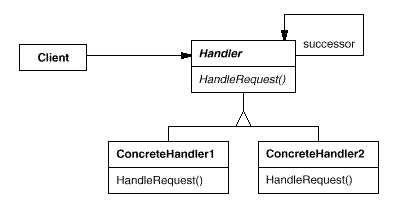标签:
| 结构 |  |
| 意图 | 使多个对象都有机会处理请求,从而避免请求的发送者和接收者之间的耦合关系。将这些对象连成一条链,并沿着这条链传递该请求,直到有一个对象处理它为止。 |
| 适用性 |
|

1 using System; 2 3 abstract class Handler 4 { 5 protected Handler successorHandler; 6 abstract public void HandleRequest(Request request); 7 public void SetSuccessor(Handler sucessor) 8 { 9 successorHandler = sucessor; 10 } 11 } 12 13 class ConcreteHandler1 : Handler 14 { 15 override public void HandleRequest(Request request) 16 { 17 // determine if we can handle the request 18 if (request.RequestType == 1) // some complex decision making! 19 { 20 // request handling code goes here 21 Console.WriteLine("request handled in ConcreteHandler1"); 22 } 23 else 24 { 25 // not handled here - pass on to next in the chain 26 if (successorHandler != null) 27 successorHandler.HandleRequest(request); 28 } 29 } 30 } 31 32 class ConcreteHandler2 : Handler 33 { 34 override public void HandleRequest(Request request) 35 { 36 // determine if we can handle the request 37 if (request.RequestType == 2) // some complex decision making! 38 { 39 // request handling code goes here 40 Console.WriteLine("request handled in ConcreteHandler2"); 41 } 42 else 43 { 44 // not handled here - pass on to next in the chain 45 if (successorHandler != null) 46 successorHandler.HandleRequest(request); 47 } 48 } 49 } 50 51 class ConcreteHandler3 : Handler 52 { 53 override public void HandleRequest(Request request) 54 { 55 // determine if we can handle the request 56 if (request.RequestType == 3) // some complex decision making! 57 { 58 // request handling code goes here 59 Console.WriteLine("request handled in ConcreteHandler3"); 60 } 61 else 62 { 63 // not handled here - pass on to next in the chain 64 if (successorHandler != null) 65 successorHandler.HandleRequest(request); 66 } 67 } 68 } 69 70 class Request 71 { 72 private int iRequestType; 73 private string strRequestParameters; 74 75 public Request(int requestType, string requestParameters) 76 { 77 iRequestType = requestType; 78 strRequestParameters = requestParameters; 79 } 80 81 public int RequestType 82 { 83 get 84 { 85 return iRequestType; 86 } 87 set 88 { 89 iRequestType = value; 90 } 91 } 92 } 93 94 /// <summary> 95 /// Summary description for Client. 96 /// </summary> 97 public class Client 98 { 99 public static int Main(string[] args) 100 { 101 // Set up chain (usually one need to be done once) 102 Handler firstHandler = new ConcreteHandler1(); 103 Handler secondHandler = new ConcreteHandler2(); 104 Handler thirdHandler = new ConcreteHandler3(); 105 firstHandler.SetSuccessor(secondHandler); 106 secondHandler.SetSuccessor(thirdHandler); 107 108 // After setting up the chain of responsibility, we can 109 // now generate requests and pass then off to the 110 // chain to be handled 111 112 // generate and fire request 113 Request newRequest = new Request(2,"This are the request parameters"); 114 firstHandler.HandleRequest(newRequest); 115 116 return 0; 117 } 118 }
行为型设计模式之职责链模式(Chain of Responsibility)
标签:
原文地址:http://www.cnblogs.com/ziranquliu/p/4666221.html